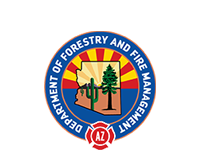2020 Wildfire Season One of the Worst in Decade
Phoenix, AZ (1/27/21) – Arizona experiences one of the worst fire seasons in nearly a decade driven by a multitude of factors, including unseasonably warm conditions, a lack of moisture, an overabundance of fine fuels, and increased recreational traffic across the state.
In 2020, 2,520 wildfires burned 978,519 acres of state, federal, and tribal lands. Of those fires, wildland fire investigators say 82% were human-caused. As compared to 2019, 1,869 wildfires burned 384,942 acres on all land jurisdictions. In 2018, 2,000 wildfires burned an estimated 165,000 acres.
Fire managers predicted high and likely extreme fire activity going into the summer due to the overgrowth of fine fuels across the Central region and within the Sonoran Desert. The Arizona Department of Forestry and Fire Management and partnering agencies prepared for the forecasted busy season with additional resources from neighboring states, early arrival of aircraft, and crew prepositioning.
As predicted, fire activity exploded in central Arizona, including across the central Wildland Urban Interface, along Interstate 17, within the Superstitions, southern Arizona, and throughout the Tonto National Forest. The nonexistent monsoon season exacerbated predictions and pushed fire activity well into the fall with October’s 9,537-acre Horse Fire on the Prescott National Forest. The lack of precipitation also kept fire restrictions in place through November.
“This was a historic fire season across the board, throughout the west, from California and Arizona to Oregon, and we are not just talking in terms of data. The extreme drought conditions, excess ground fuel, and inadequate moisture created fast moving, large-scale fires. Under certain conditions, a majority of these fires produced extreme fire behavior that pushed right through retardant lines and created very dangerous situations. This week’s recent moisture only helps our drought situation for the short term and residents cannot let their guards down. We need people to be proactive and protect their properties and be fire safe when outdoors,’ said John Truett Fire Management Officer for the Arizona Department of Forestry and Fire Management.
It is imperative residents create defensible space around their properties and do their part to help prevent wildfires. Always pay attention to surroundings when working outdoors, use a spark arrester, and never burn on windy days. Put out campfires completely, secure tow chains, and abide by fire restrictions.
Last year was as one of the most severe and destructive of wildfire seasons, but it was not the worst. In 2011, Arizona hit the million-acre mark in part due to the Wallow Fire in northeastern Arizona. That year, 1,988 fires burned a total of 1,016,428 acres.


